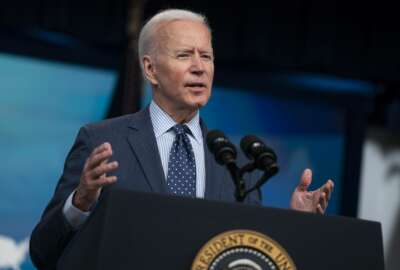If you thought federal contract spending shot through the roof last year, you’re right
Last year was a good one to be a federal contractor because of the pandemic and a few other things. Federal contract spending went up by double digits.
Best listening experience is on Chrome, Firefox or Safari. Subscribe to Federal Drive’s daily audio interviews on Apple Podcasts or PodcastOne.
Last year was a good one to be a federal contractor because of the pandemic and a few other things. Federal contract spending went up by double digits. And there were a few changes to the list of the largest federal contractors. Federal Drive with Tom Temin got the highlights from Bloomberg federal market analyst Laura Criste.
Interview transcript:
Tom Temin: Laura, good to have you back.
Laura Criste: Thanks for having me.
Tom Temin: And this is the annual release of the Bloomberg Top 200 but first, give us a sense of the spending rises. I mean, these were pretty dramatic.
Laura Criste: Yeah, so in fiscal 2020, it was a record high spending of $682 billion, which is pretty crazy, just comparing it to the previous year of $599 billion in fiscal 2019. As you said, a lot of that was due to COVID. But we can talk about some of the other trends as well.
Tom Temin: Yes, COVID. I think we understand a lot of the spending, and it was all over the place. Were there any other factors driving that, though last year?
Laura Criste: Yeah. So two areas that we really like to concentrate on at Bloomberg Government are IT and professional services. And both of those markets would have probably grown in fiscal 2020, compared to 2019. Historical trends showed they would grow. It’s a little hard to kind of completely decouple COVID spending and regular market spending. But just based on what we saw going on in both of those markets, I think both of those would have continued with IT in particular, with COVID, we saw more increases in like remote work-type spending. So that was going to be hardware and security. But we also saw things like IT modernization spending increasing, which very likely would have continued increasing, even without COVID.
Tom Temin: And which agencies accounted for the single biggest increase in spending?
Laura Criste: So top agencies are going to be HHS, which is mostly going to be COVID. We’re going to talk about that a lot I think, even though people are tired talking about it. VA spending went up and that was not necessarily because of COVID. There’s a big contract called Patient-Centered Community [Care] with TriWest. They provide medical services, and it wasn’t all COVID. VA increased about $3 billion because of the pandemic. But overall, it increased more like 10. So we saw some increases there that weren’t pandemic-related. The Navy saw a big increase, mostly due to F-35 purchases. So those are kind of some of the big ones that I saw.
Tom Temin: And there was also a fairly healthy increase in the use of other transaction authorities. And I think that’s something that industry likes to get. And it’s certainly something government likes to do, because it’s easier than awarding under the FAR.
Laura Criste: For sure, yeah. So we’ve been seeing OTA increases for the past few years. And it’s something that my team has covered pretty heavily. For a variety of things like prototypes and R&D-type contracts, IT has become more common for OTA use. But actually, again, the big increase for OTA’s – it was going to be in the medical in R&D to help develop vaccines and medical equipment due to the pandemic.
Tom Temin: So was Operation Warp Speed, was that part of the contracting spending, the spending to develop the vaccines in the first place?
Laura Criste: I’m not 100% sure if that overlaps. I haven’t seen Operation Warp Speed showing up in the OTA stuff in particular, but –
Tom Temin: I just meant in the general contracting spending.
Laura Criste: Oh, yeah, it showed up. I mean, you can see the vaccines being developed, you can see the logistics for moving them from one place to another. Manufacturing – you find that in the contract data.
Tom Temin: Okay, and you’re projecting a pretty good year for 2021 to based on trends you’re looking at, just give us a sense of where that’s headed.
Laura Criste: So 2021 spending is a little bit hard to project. In the report, you probably saw that we have a pretty wide range of a projection from $600 billion, which is fiscal 2019 levels to $695 billion, which is exceeding fiscal 2020 levels. And the reason for that is the stimulus money, it’s a little bit hard to know, are we going to continue moving upward with the COVID stimulus spending? CARES Act money expires at the end of fiscal 2021, but [American Rescue Plan Act of 2021] money doesn’t, at least not all of it. So we can we see this multi-year money and we don’t know exactly when agencies are going to spend it. But we’re kind of projecting in this pretty wide range. Some areas where we do think there will be increases are going to be IT and professional services like we talked about. For IT in particular, with Biden’s cybersecurity executive order, and in general the administration’s focus on cybersecurity, and then also with that executive order an emphasis on cloud. So we expect IT to increase in those two areas in particular. And then in IT modernization in general – digital services is another area where agencies are trying to kind of improve. So those are some areas where we definitely expect to see increases in 2021.
Tom Temin: We’re speaking with Laura Criste, the federal market analyst at Bloomberg Government, and let’s get to the rankings of contractors. I guess people won’t be surprised to know that Lockheed Martin remained the No. 1 federal contractor, but by nearly a three-to-one margin over the next one, No. 2, which is Raytheon. Not quite three-to-one, two-and-a-half-to-one. So they’re never going to be knocked off the top, are they?
Laura Criste: I don’t see it, it’s a little hard to knock down your top aircraft producer, especially in fiscal 2021, when they received over $24 billion just for the F-35, which is I think about a third of what they were obligated in fiscal 2020. I’m not sure that’s going to continue to be the case with the new administration, we’ll have to see what happens in fiscal 2021 as far as that level of spending. But I don’t think they’re going to get knocked down anytime soon.
Tom Temin: And you did mention TriWest Health Care Alliance in that big VA deal. So they went from No. 42 to No. 9 in the top 200, so that explains that one. There was one oddball one, though, that went from something like 130,000 on the list of No. 29: Amentum Patent Holdings. And what was the phenomenon there?
Laura Criste: Amentum in fiscal 2019 wasn’t really a company. So AECOM sold their management services division, which is Amentum. So it kind of went from not really existing to being No. 29. And what’s kind of interesting is that AECOM, so it ranked 19 in fiscal 2019. So you could compare Amentum to that kind of, but they weren’t part of that – the whole company didn’t move. But AECOM did drop to No. 95. So you can see that Amentum was a huge part of AECOM and when you separate them, you get No. 29 and No. 95, versus 130,000 and No. 19. So we still have two companies now on the top 200, rather than one, I guess. It was a big company previously and is still.
Tom Temin: Alright, so but at $2.6 billion it’s not trivial sales. And it looks like to make the 200 list, you have to start with about $359 million in sales to make that list. So there’s many, many, many, many small contractors. But among that top 200 is people approaching the hundreds of millions and billions of dollars.
Laura Criste: They’re all pretty large.
Tom Temin: Right, so anything else we need to know about this top 200 list?
Laura Criste: I think a couple other ones that might be interesting that we had talked about are Fisher Sand & Gravel. That one won some large border wall contracts in fiscal 2020. So we may not see that one next year. And we’ll have to see what happens with that it’s kind of hard to end contracts once they’re started. But I know that the Biden administration did want to try to do that. And then analytic services was another one that I think is interesting, because it has a company subsidiary, that’s called ATI and they manage some consortia. They rose to No. 6. They keep rising, actually, each year because of this subsidiary that manages these consortia because of all the OTA transactions that are going through that company. So it’s kind of a weird one where the company is not actually receiving all that money, but they keep popping up higher and higher in the BGov 200 because that money is going to other contractors, so maybe a good consortia or set of consortia to join for our listeners? Because they might be able to win some of that work that’s going through ATI or analytic services.
Tom Temin: And finally, the number of mergers and acquisitions was down somewhat in 2020, relative to ’19 and ’18, where there were a good 400 of them or so. To what do you attribute that trend?
Laura Criste: I attribute that to the pandemic as well. I think companies were scared to spend a lot of money because they didn’t know what their financial situation was going to be like. We’ve actually found at least in the IT market that fiscal 2021 mergers and acquisitions are probably going to more than make up for M&A activity shortfalls, or I don’t know if you want to call it that but the dip in 2020 with M&A. More and more companies are maybe buying the companies that they were thinking about previously, or making those investments now rather than when they were a little bit more worried about what the economy might look like.
Tom Temin: Well, one thing you can say this market is always exciting, isn’t it?
Laura Criste: Oh, for sure. Always lots of changes.
Tom Temin: Laura Criste is federal market analyst at Bloomberg Government. Thanks so much for joining me.
Laura Criste: Thank you.
Copyright © 2025 Federal News Network. All rights reserved. This website is not intended for users located within the European Economic Area.
Tom Temin is host of the Federal Drive and has been providing insight on federal technology and management issues for more than 30 years.
Follow @tteminWFED






